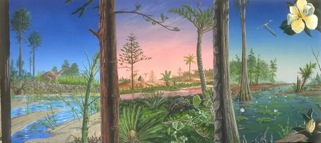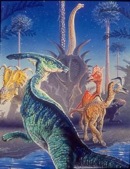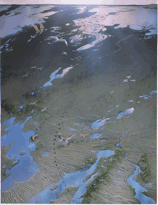Ancient Plant Life
Many dinosaur books forget to mention the rich and often strange plant life that coexisted with the dinosaurs. Here, we see vegetation from three ages of dinosaurs. Triassic plants (left scene) include ferns and horsetails along the riverbank. A palm-like cycad is on the far shore. The early dinosaur Plateosauras stands in front of trees similar to today's Sequoias. In the center landscape, a Dilophosaurus hides behind Ginkgo leaves in a Jurassic jungle. Cycads are to the left. Trees at left are similar to today's Norfolk Island Pines. Tree ferns grow at the right. In the Cretaceous fossils (right scene) we find the first flowers. Here we see Magnolias and flowering water lilies in a Bald Cypress swamp. High above is a flying Quetzalcoatalus.
Dinosaur Fashion
This painting depicts the many different horns, plates and frills that dinosaurs had. Left to right: Pachyrhinosaurus, Parasaurolophus, Styracosaurus, Lambeosaurus, Corythosaurus and Stegoceras.
In the background is the neck and head of a Brachiosaurus. No one knows what colors the dinosaurs were, but it is interesting to note that the creatures most resembling dinosaurs today are birds and, to a lesser extent, the reptiles. Both of these groups of modern animals have members with striking colors. Dinosaurs may have been camouflaged, or they may have had spectacular coloration. With a world full of fossils, all we can do is guess.
In the background is the neck and head of a Brachiosaurus. No one knows what colors the dinosaurs were, but it is interesting to note that the creatures most resembling dinosaurs today are birds and, to a lesser extent, the reptiles. Both of these groups of modern animals have members with striking colors. Dinosaurs may have been camouflaged, or they may have had spectacular coloration. With a world full of fossils, all we can do is guess.
The Red Gulch Trackway
Tyrannosaurus Rex
A full-grown Tyrannosaurus rex chases a pack of Troodons for a
scrumptious meal of Triceratops meat (aged to perfection).
Some paleontologists believe that Trex was more scavenger
than hunter. Like lions in Africa today, Tyrannosaurs were
probably opportunistic feeders, eating a variety of meals
from "on the hoof" to road kill.
Leonardo
This painting depicits a group of Brachylophosauruses browsing in a late
Cretaceous waterway. The skin textures and anatomy are based on the
subadult specimen Leonardo, discovered with much of his skin still on,
and adult specimens Roberta and Elvis, along with the baby
Brachylophosaur Peanut. These specimens were unearthed by the
Judith River Institute/Phillips County Museum in Malta, Montana.




